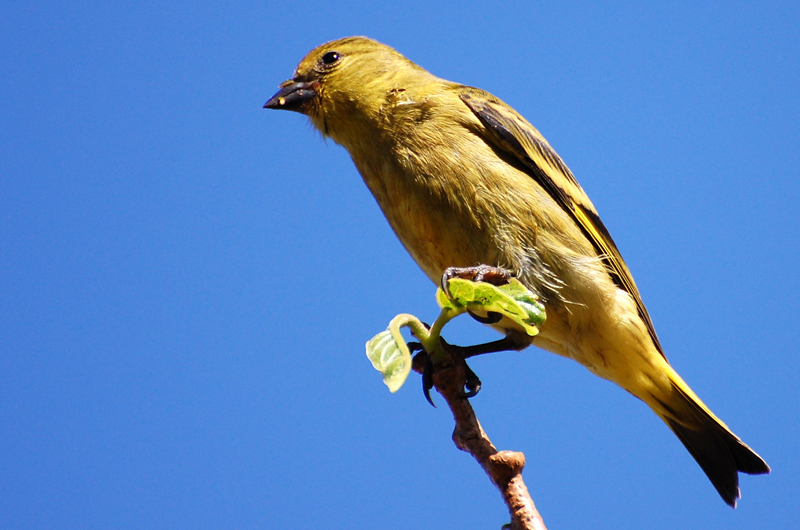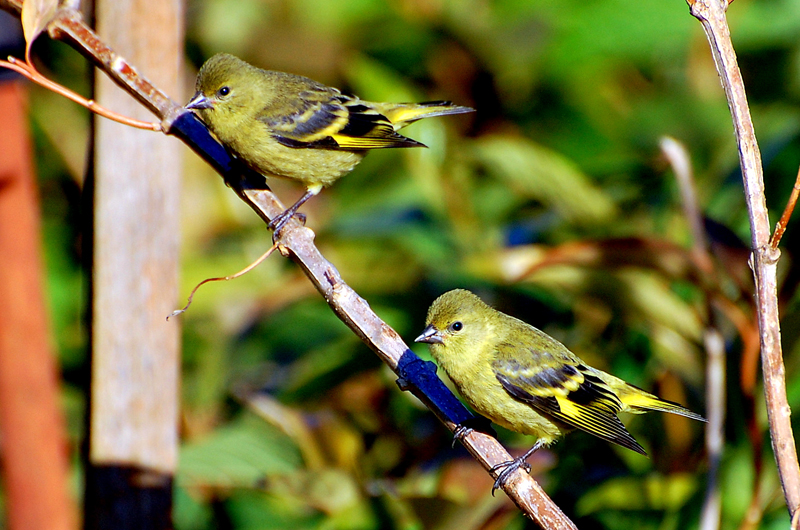Adult (male) Black-Headed Yellow Siskin. Photo: Dario Sanches
Article kindly provided by Glenn Johnson
Introduction
I have kept the Black-Headed Yellow Siskin (Carduelis magellanica) for the last ten years, I’ve found them to be a hardy, long-lived, easy to cater for bird. They are quiet, an exotic looking bird, that truly adds that real point of interest to your collection. Most breeders refer to this bird as the Mexican Siskin. I’m not sure where this terminology comes from as the natural range of this species is nowhere near Mexico, however wrong, most breeders refer to them as Mexican Siskins.
Natural Range
The Black-Headed Yellow Siskin has a large range in South America, through the western side of Chile and the southern eastern corner of Brazil. They are found in open grasslands, cultivated fields in and around villages in their range. They are considered common in their natural range from reading Russell Kingston’s excellent book “Keeping and Breeding Finches and Seed Eaters”, he states, that unlike the Black headed Red Siskin, the Yellow Siskin is largely left alone for the pet market and hasn’t suffered the pressure of being targeted by trappers.
Adult (female) Black-Headed Yellow Siskin. Photo: Dario Sanches
Sexing
The Yellow Hooded Siskins are sexually dimorphic, making sexing easy. Only the cock birds sport the bright colours. The males head is shiny black; over its back is olive yellow, which is brighter on the back of the neck and tail coverts. The underbelly is yellow, the wings and tail are black striped with yellow. The hens are much duller in colour, lacking the tell-tale black head, the under parts are olive grey with tinges of green streaking. The underbelly is drab grey running into white towards the under tail. The wings are black, edged with yellow, much like the cock bird – only slightly duller. Both the hen and cock are 125mm in length and weighs 12gm – for comparison, a typical Gouldian length is 140-145 in length and weighs 15 grams.
“Black-Headed Yellow Siskins are quiet, an exotic looking bird, that truly adds that real point of interest to your collection. Most breeders refer to this bird as the Mexican Siskin. I’m not sure where this terminology comes from as the natural range of this species is nowhere near Mexico, however wrong, most breeders refer to them as Mexican Siskins.”
Feeding
My birds are fed a good quality finch mix comprised of typical finch seeds such as Pannicum, Red, Japanese and French White Millet as well as Canary and a small amount of hulled oats. This is fed year round. During the breeding period I supply a separate dish of “Black seeds” – this mix is comprised of Niger, Maw, Black and White lettuce, rye grass and cracked sunflower seed. I buy my cracked sunflower seed from a health food store, you could do it yourself, however I find that with the small amount I have to feed, only keeping three pairs, it’s easier to buy it. I feed a soft food during the breeding season. The mix I feed works for me, however there is a huge variety of commercial and homemade soft foods being used, so find one that suits you. The one I use is easy to prepare and the ingredients are inexpensive and readily bought. My mix is:
- Plain sponge cake
- “Wombaroo” soft food mix
- “Polenta” (processed corn meal)
- 1 egg – shell as well
The sponge cake is put into a small bucket and mixed by hand until it’s thoroughly mixed. This cake is put into an airtight container. I take out about two cups full of the cake mix and place back into a small bucket. To this mix I put 1 dessert spoon of both the polenta and “Womabroo” soft food mix and thoroughly mix. I hard boil a small egg, and place the egg, shell and all, into the cake mix an place in blender and pulse gently till you get that moist flaky mix you want. If you make the mix too wet just add a bit more of the sponge cake mix.
This mix is not fed all year round, only when nesting begins. Keep in mind all the other birds will get stuck into this mix as well, so make sure your siskin's are getting their fair share, maybe a couple of feeding areas to give them a fair chance.
Grit is supplied by Rob Lenton who makes a mix called “Hi Cal”. Rob now lives around the Shoalhaven. His mix contains small shell grit, candrua shell, crushed charcoal, cuttlebone and fowl egg shell. I’ve found the mix to be a big favourite for all my birds.
Like all finches we keep, Siskins love green food. They love all types, and variety is important. Milk thistles, chickweed, African Veldt grass are just a few favourites. Corn on the cob and Lebanese cucumber are also eagerly taken.
All my birds are fed live food comprised of mostly bush fly maggots and some meal worms, and Siskins will partake in them especially when feeding chicks. Termites will also be taken, however due to time and availability, I no longer feed termites, but for those who do, I think you would do well.
At the moment a few companies are making soft food mixes which have colour enhancers such as dried capsicum and canthaxanthin and carotenoids. This with a good variety of food may help to enhance the colour of this already beautiful bird.
Adult (male) Black-Headed Yellow Siskin. Photo: Dario Sanches
Compatibility
Black Hooded Yellow Siskins, mix with most other species, however I have found that Cubans and Golden Song Sparrows tend to show a dislike towards them. Mixing any types of Siskins together in an obvious no no, as hybrids can occur and are a complete waste of time.
Siskins are polygamous, meaning that you can run more than one hen with a cock bird. I currently run one aviary with one cock and two hens. Running more than two hens with one cock usually doesn’t work, as it makes the cock bird work too hard, he can handle two hens, however that extra hen takes too much. I would never have more than one cock together as they will fight, I’ve seen them trying to kill each other when in adjoining aviaries so I can imagine what would happen if together.
Housing
Housing Siskin or Cubans, or Green Singing side by side is also hazardous as fighting between aviaries may occur. I’ve seen Siskins breed in canary breeding cabinets, small bird room aviaries up to huge planted flight aviaries. My aviaries have the shelters well protected with an open flight. The shelter is lined with tea-tree branches with an assortment of potted plants in the flights. I have had Siskins build both in the protected shelter area as well as the plants in the flights. I must say however, most of my Yellow Siskins prefer the sheltered area and my Red Siskins seem to prefer to nest in the potted plants in the flight.
Adult (male) Black-Headed Yellow Siskin feeding its young. Photo: Dario Sanches
Nesting
I supply a variety of nesting receptacles such as open wicker baskets, canary pans and open nest boxes. The majority of my birds prefer to build their own nests. They make a small cup shape nest normally only waist or chest high in the aviary in the most secluded area they can find.
I supply teased Hessian, coconut fibre, feathers and Pampas grass heads. I’ve found all the nest buildings is done by the hen. When you see the cock bird singing more than usual and he is feeding the hen, you know you’re in business so make sure you have the nesting material available. This also is the time to make the live food more available to coerce the breeding procedure. Don’t be put off if you see the cock bird chasing the hen, this is also part of the mating habit.
The average clutch is two to four pale blue eggs dotted with brown dots. Incubation is thirteen days and is done entirely by the hen. Only the hens feed the chicks whilst in the nest. I’ve found the Yellow Siskin hens not to be easily disturbed when on the nest, but don’t push it and try and leave them alone. Chicks fledge around eighteen days and it’s not uncommon to have the chicks climbing around the shrubbery before fully fledging. They are independent at about four weeks and can be removed from the aviary or left with the parents.
Health
Siskins generally are a long lived hardy species, a normal worming and coccidcosis programme should be carried out. Unfortunately they can suffer like canaries from mosquito bites on the feet and around the beak so be aware if you live in areas that have a lot of mozzies.







